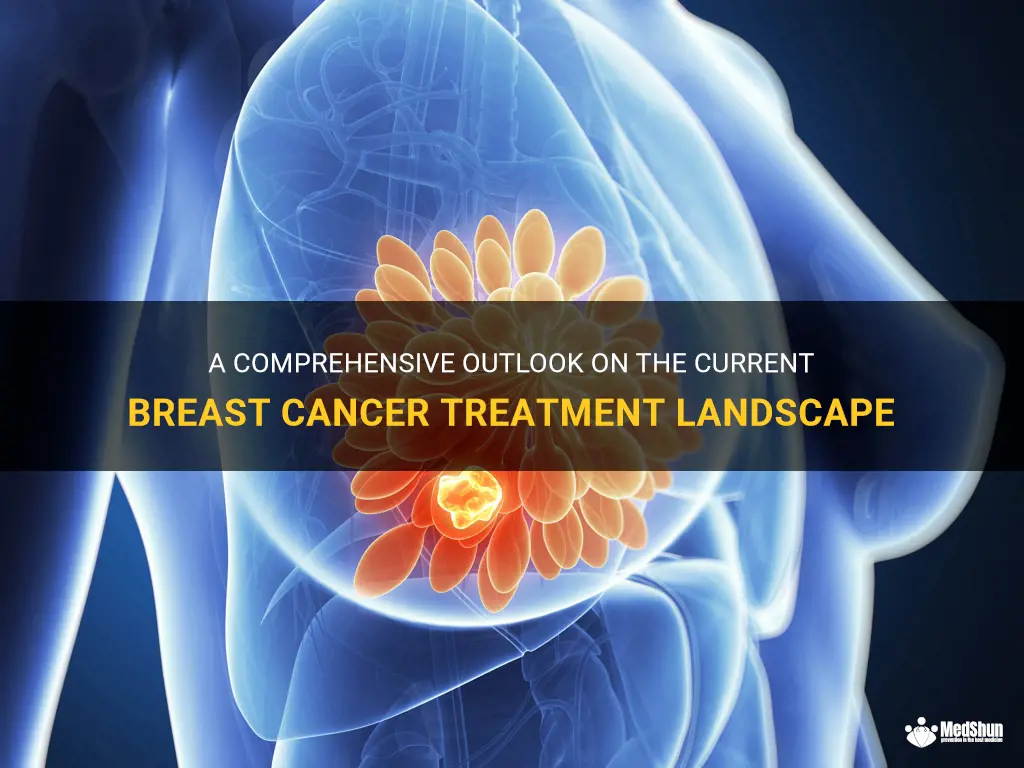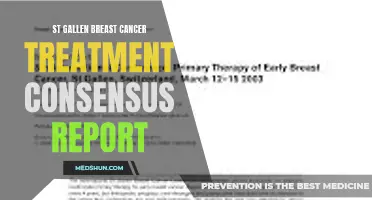
Breast cancer is a highly prevalent and potentially deadly disease that affects millions of women worldwide. As research and medical advancements continue to evolve, the treatment landscape for breast cancer is constantly evolving. From surgery and radiation to targeted therapies and immunotherapy, there are now a multitude of options available to help patients in their fight against this devastating disease. In this article, we will explore the current breast cancer treatment landscape, discussing the different approaches and advancements that have revolutionized care in recent years. Whether you or a loved one are facing a breast cancer diagnosis, or you simply have an interest in the field of oncology, this exploration of the treatment landscape will provide valuable insights into the ongoing battle against breast cancer and the advancements that are bringing hope to patients worldwide.
| Characteristics | Values |
|---|---|
| Types of breast cancer treatments | Surgery, radiation therapy, chemotherapy, hormonal therapy, targeted therapy |
| Goals of breast cancer treatment | Cure, control, palliative |
| Treatment options for early-stage breast cancer | Surgery with or without radiation therapy, hormonal therapy |
| Treatment options for advanced-stage breast cancer | Chemotherapy, targeted therapy, hormonal therapy, radiation therapy |
| Common side effects of breast cancer treatment | Fatigue, hair loss, nausea, vomiting, weight changes |
| Personalized treatment options for breast cancer | Genetic testing, targeted therapies based on tumor characteristics |
| Timeline of breast cancer treatment | Usually lasts for several months to years, depending on the stage of cancer |
| Importance of early detection and timely treatment | Higher chances of successful treatment, increased survival rates |
| Role of multidisciplinary team in treatment planning | Oncologist, surgeon, radiation oncologist, pathologist, radiologist |
| Impact of clinical trials on treatment advancements | Access to experimental treatments, potential for improved outcomes |
What You'll Learn
- What are the current treatment options available for breast cancer, including surgery, chemotherapy, radiation therapy, targeted therapy, and hormone therapy?
- How has the treatment landscape for breast cancer evolved over the years, and what advancements have been made in the field?
- What are the different stages of breast cancer, and how does treatment vary depending on the stage?
- Are there any promising new treatments or technologies that are being developed for breast cancer treatment?
- How does personalized medicine play a role in breast cancer treatment, and how are genetic tests used to determine the most effective treatment plan for individual patients?

What are the current treatment options available for breast cancer, including surgery, chemotherapy, radiation therapy, targeted therapy, and hormone therapy?
Breast cancer is a serious and potentially life-threatening disease that affects millions of women worldwide. Fortunately, there are several treatment options available to help combat this disease and improve the chances of survival. In this article, we will explore the current treatment options for breast cancer, including surgery, chemotherapy, radiation therapy, targeted therapy, and hormone therapy.
Surgery is often the first line of treatment for breast cancer. The most common surgical procedure used is a lumpectomy or partial mastectomy, in which only the tumor and a small amount of surrounding tissue are removed. In some cases, a mastectomy may be necessary, which involves the removal of the entire breast. In addition to removing the tumor, nearby lymph nodes may also be removed to determine if the cancer has spread.
After surgery, many patients undergo chemotherapy, which involves the use of powerful drugs to kill cancer cells. Chemotherapy can be administered orally or intravenously and is typically given in cycles to allow the body time to recover between treatments. While chemotherapy can have side effects such as hair loss and nausea, it is a crucial part of the treatment process and has been proven to increase survival rates.
Radiation therapy is often used following surgery to kill any remaining cancer cells that may have been missed. This treatment involves directing high-energy X-rays or other types of radiation at the affected area. Like chemotherapy, radiation therapy can have side effects such as fatigue and skin irritation, but these are usually temporary and subside after treatment is complete.
In recent years, targeted therapy has become a popular treatment option for breast cancer. This type of therapy uses drugs that specifically target certain characteristics or genes of the cancer cells. For example, Herceptin is a targeted therapy drug that targets breast cancer cells that overproduce a certain protein called HER2. By targeting these specific characteristics, targeted therapy can help stop the growth and spread of cancer cells while minimizing damage to healthy cells.
Hormone therapy is another treatment option for breast cancer, particularly for those with hormone receptor-positive breast cancer. This type of cancer grows in response to hormones such as estrogen and progesterone. Hormone therapy drugs work by blocking the effects of these hormones or by reducing their production. This can help slow or stop the growth of cancer cells and reduce the risk of recurrence.
In some cases, a combination of these treatment options may be used to provide the best possible outcome. For example, a patient may undergo surgery followed by chemotherapy and radiation therapy. In addition, targeted therapy and hormone therapy may be utilized to further enhance the effectiveness of the treatment plan.
It is important to note that each patient's treatment plan will vary depending on the specific characteristics of their cancer, stage of the disease, and individual factors such as age and overall health. Therefore, it is crucial for patients to work closely with their healthcare team to develop a personalized treatment plan that best suits their needs.
In conclusion, there are several treatment options available for breast cancer, including surgery, chemotherapy, radiation therapy, targeted therapy, and hormone therapy. These treatments may be used individually or in combination to provide the best possible outcome for patients. By staying informed and working closely with their healthcare team, breast cancer patients can take an active role in their treatment plan and improve their chances of survival.
The Top Hospitals in the UK for Breast Cancer Treatment
You may want to see also

How has the treatment landscape for breast cancer evolved over the years, and what advancements have been made in the field?
Breast cancer is the most commonly diagnosed cancer and the leading cause of cancer-related deaths in women worldwide. Over the years, significant advancements have been made in the treatment landscape for breast cancer, leading to improved outcomes and increased survival rates for patients.
One of the major changes in the treatment of breast cancer is the shift towards personalized medicine. Previously, breast cancer treatment was largely based on the stage of the disease and the presence of certain biomarkers. However, with advancements in genomic testing and molecular profiling, treatment decisions can now be made based on the unique characteristics of the tumor.
For example, the discovery of certain gene mutations, such as BRCA1 and BRCA2, has allowed for the development of targeted therapies. These mutations are found in a small percentage of breast cancer cases and are associated with a higher risk of developing the disease. Today, drugs like PARP inhibitors can specifically target these mutations and improve treatment outcomes for patients with BRCA mutations.
In addition to targeted therapies, there have been significant advancements in the field of immunotherapy. Immunotherapy works by boosting the body's immune system to recognize and attack cancer cells. In breast cancer, immunotherapy has shown promise in treating certain subtypes of the disease, such as triple-negative breast cancer.
One such immunotherapy drug that has made a significant impact is pembrolizumab. It is a PD-1 checkpoint inhibitor that has been approved for use in combination with chemotherapy for triple-negative breast cancer patients whose tumors express the PD-L1 protein. This treatment has provided a new option for patients with limited treatment choices and has improved overall survival rates.
Another area of advancement is in the development of targeted therapies that specifically inhibit the signaling pathways involved in breast cancer growth. For example, the discovery of the HER2 protein and its role in breast cancer has led to the development of targeted therapies, such as trastuzumab and lapatinib. These drugs specifically target the HER2 protein and have significantly improved outcomes for patients with HER2-positive breast cancer.
Furthermore, advancements in surgical techniques and radiation therapy have also played a significant role in the management of breast cancer. The introduction of techniques such as oncoplastic surgery, which combines tumor removal with plastic surgery techniques, allows for better cosmetic outcomes and improved quality of life for patients. Additionally, advances in radiation therapy, such as hypofractionation, have shortened treatment times and reduced side effects.
It is important to note that these advancements in breast cancer treatment have been the result of extensive research, clinical trials, and collaboration among scientists, clinicians, and pharmaceutical companies. The treatment landscape for breast cancer continues to evolve rapidly, and potential new therapies, such as targeted therapies, immunotherapies, and genomics-based treatments, are being investigated.
In conclusion, the treatment landscape for breast cancer has evolved significantly over the years, leading to improved outcomes and increased survival rates. The shift towards personalized medicine, advancements in targeted therapies, immunotherapies, surgical techniques, and radiation therapy have all contributed to these advancements. The future of breast cancer treatment holds much promise, with ongoing research focused on developing new therapies that specifically target the unique characteristics of each patient's tumor.
Improving Breast Cancer Treatment in Australia: New Strategies and Innovations
You may want to see also

What are the different stages of breast cancer, and how does treatment vary depending on the stage?
Breast cancer is a complex disease that progresses through various stages. The specific stage of breast cancer helps doctors determine the extent of the disease and plan the most appropriate treatment strategy. The stages range from 0 to IV, with stage 0 being the earliest and stage IV being the most advanced.
Stage 0: Stage 0 breast cancer, also known as ductal carcinoma in situ (DCIS), is the earliest stage and is non-invasive. It means that the cancer cells are contained within the milk ducts and have not spread into the surrounding breast tissue. Treatment options for stage 0 breast cancer typically include lumpectomy, which involves removing the cancerous tissue while preserving the breast, or mastectomy, where the entire breast is removed.
Stage I: Stage I breast cancer is characterized by the presence of a small tumor within the breast that has not spread to the lymph nodes or distant organs. Treatment options may include surgery, such as lumpectomy or mastectomy, followed by radiation therapy to destroy any remaining cancer cells. In some cases, chemotherapy or targeted therapy may also be recommended.
Stage II: Stage II breast cancer is further divided into two subcategories: IIA and IIB. In stage IIA, the tumor is still small and has not spread to the lymph nodes, or the tumor is larger but has spread to a few nearby lymph nodes. In stage IIB, the tumor may be larger and has spread to the lymph nodes, or it has invaded the nearby tissues, such as the chest wall or skin.
Treatment for stage II breast cancer often involves a combination of surgery, radiation therapy, and chemotherapy. The specific treatment plan depends on factors such as the size of the tumor, the number of affected lymph nodes, and the presence of hormone receptors or HER2/neu protein. Hormone therapy or targeted therapy may also be recommended, depending on the tumor characteristics.
Stage III: Stage III breast cancer is divided into three subcategories: IIIA, IIIB, and IIIC. In stage IIIA, the tumor may be any size but has spread to multiple lymph nodes. In stage IIIB, the tumor has invaded the chest wall or caused swelling or ulceration of the breast. In stage IIIC, the cancer has spread to the lymph nodes above or below the collarbone.
Treatment for stage III breast cancer usually involves a combination of surgery, radiation therapy, chemotherapy, and targeted therapy. In some cases, neoadjuvant therapy – chemotherapy or hormone therapy given before surgery – may be recommended to shrink the tumor and make it easier to remove. Following surgery, additional treatments like radiation therapy and systemic treatments are given to reduce the risk of recurrence.
Stage IV: Stage IV breast cancer, also known as metastatic breast cancer, is the most advanced stage. At this stage, the cancer has spread to distant organs, such as the bones, liver, lungs, or brain. Treatment for stage IV breast cancer aims to control the spread of the disease, relieve symptoms, and improve quality of life.
Treatment options for stage IV breast cancer may include systemic therapies, such as chemotherapy, hormone therapy, targeted therapy, or immunotherapy. These treatments are designed to reach and destroy cancer cells throughout the body. Local treatments like surgery or radiation therapy may be used to help alleviate symptoms or manage specific sites of metastasis.
In conclusion, the treatment of breast cancer varies depending on the stage of the disease. Early-stage breast cancer is often treated with surgery and radiation therapy, while more advanced stages may require a combination of treatments, including chemotherapy, targeted therapy, and hormone therapy. It is important for patients to work closely with their healthcare team to develop an individualized treatment plan based on their specific stage and tumor characteristics.
The Best Approaches to Treating Grade 1 Breast Cancer: A Comprehensive Guide
You may want to see also

Are there any promising new treatments or technologies that are being developed for breast cancer treatment?
Breast cancer is a serious and prevalent disease that affects millions of women worldwide. While current treatment options such as surgery, chemotherapy, and radiation therapy have improved survival rates, researchers are constantly working to develop new and more effective treatments. In recent years, there have been several promising developments in the field of breast cancer treatment, including targeted therapies, immunotherapies, and innovative surgical techniques.
One of the most exciting advancements in breast cancer treatment is the development of targeted therapies. These therapies work by identifying specific molecules or genetic mutations that are involved in the development and progression of breast cancer. By targeting these specific molecules, targeted therapies can selectively kill cancer cells while minimizing damage to healthy cells. For example, the drug trastuzumab targets the HER2 protein, which is overexpressed in about 20% of breast cancer patients. Clinical trials have shown that trastuzumab can significantly improve survival rates in these patients.
Another promising area of research is immunotherapy, which harnesses the power of the immune system to fight cancer. One type of immunotherapy called immune checkpoint inhibitors works by blocking proteins that prevent immune cells from attacking cancer cells. These inhibitors have shown promising results in clinical trials for other types of cancer, and researchers are currently investigating their use in breast cancer. For example, the drug pembrolizumab has shown encouraging results in patients with triple-negative breast cancer, a subtype of breast cancer that is often difficult to treat.
In addition to novel drug therapies, researchers are also exploring innovative surgical techniques to improve outcomes for breast cancer patients. One such technique is oncoplastic surgery, which combines cancer surgery with plastic surgery techniques to achieve better cosmetic results. By reshaping the breast tissue after tumor removal, oncoplastic surgery can help women maintain a natural appearance and improve their quality of life. Another emerging surgical technique is nipple-sparing mastectomy, which removes the breast tissue while preserving the nipple and areola. This procedure can be used for certain patients with early-stage breast cancer and can provide a more natural-looking breast reconstruction.
While these advancements in breast cancer treatment show great promise, it is important to note that they are still in the early stages of development. Further research and clinical trials are needed to determine their effectiveness and safety. It is also important to consider that not all new treatments or technologies will be suitable for every patient. Breast cancer is a complex disease with many different subtypes, and individualized treatment plans are necessary to achieve the best outcomes.
In conclusion, there are several promising new treatments and technologies being developed for breast cancer treatment. Targeted therapies, such as trastuzumab, and immunotherapies, such as immune checkpoint inhibitors, are showing great potential in improving survival rates for breast cancer patients. Innovative surgical techniques, such as oncoplastic surgery and nipple-sparing mastectomy, are also being developed to improve cosmetic outcomes and quality of life. However, further research and clinical trials are needed to fully understand the effectiveness and safety of these new approaches.
New Advances in Treatment for Breast Cancer Skin Metastasis
You may want to see also

How does personalized medicine play a role in breast cancer treatment, and how are genetic tests used to determine the most effective treatment plan for individual patients?
Breast cancer is a complex disease with various subtypes, each requiring different treatment approaches. Personalized medicine has emerged as a powerful tool to tailor breast cancer treatment plans to individual patients. One crucial aspect of personalized medicine in breast cancer treatment is the use of genetic tests to determine the most effective treatment plan for each patient.
Genetic tests play a vital role in identifying specific genetic alterations or mutations in a patient's tumor that can guide treatment decisions. This information helps oncologists to better understand the biology of the tumor and select targeted therapies that can specifically inhibit the growth of cancer cells.
One widely used genetic test for breast cancer is the HER2/neu test, which determines the overexpression of the HER2 protein. HER2-positive breast cancers tend to grow more aggressively, but targeted therapies like trastuzumab (Herceptin) can effectively inhibit the HER2 protein and slow down cancer growth. By identifying HER2-positive breast cancers through genetic tests, oncologists can devise a treatment plan that includes targeted therapies like Herceptin to improve patient outcomes.
Another genetic test commonly used in breast cancer treatment is the estrogen receptor (ER) and progesterone receptor (PR) test. These receptors help determine if the cancer cells are hormone receptor-positive or hormone receptor-negative. Hormone receptor-positive breast cancers can be effectively treated with hormone therapies like tamoxifen or aromatase inhibitors. Genetic testing allows oncologists to identify patients who will benefit from hormone therapies and exclude those who will not.
Genetic testing also plays a role in predicting a patient's response to chemotherapy. For example, the Oncotype DX test analyzes the expression of certain genes in breast cancer cells and predicts the likelihood of a recurrence. This test helps oncologists determine if a patient will benefit from chemotherapy or if other treatment options should be considered. By avoiding unnecessary chemotherapy, patients can be spared from potential side effects while ensuring they receive the most effective treatment.
One real-life example of the impact of genetic testing in breast cancer treatment is the case of a 40-year-old woman diagnosed with early-stage breast cancer. A genetic test revealed that her tumor was HER2-positive, indicating that she would benefit from Herceptin. Additionally, the test showed that her tumor was hormone receptor-positive, suggesting that hormone therapies should be included in her treatment plan. Based on this personalized information, the patient's oncologist designed a comprehensive treatment approach that combined surgery, radiation therapy, Herceptin, and hormone therapy tailored specifically to her tumor's genetic profile.
In conclusion, personalized medicine has revolutionized breast cancer treatment by incorporating genetic tests into the decision-making process. Genetic tests allow oncologists to determine the specific genetic alterations present in a patient's tumor, guiding treatment decisions and improving patient outcomes. By tailoring treatment plans to individual patients based on their genetic profile, personalized medicine brings us one step closer to more effective and targeted breast cancer therapies.
Frequently asked questions
The most common treatment options for breast cancer include surgery, radiation therapy, chemotherapy, hormone therapy, targeted therapy, and immunotherapy. The specific treatment plan will depend on various factors such as the stage of cancer, the presence of hormone receptors, and the individual patient's health and preferences.
Chemotherapy is a commonly used treatment for breast cancer and can be very effective in killing cancer cells and preventing their spread. The effectiveness of chemotherapy depends on various factors such as the stage of cancer, the specific drugs used, and the individual patient's response to treatment. In some cases, chemotherapy may be used before surgery to shrink tumors and make them easier to remove, or after surgery to kill any remaining cancer cells.
Yes, there are several emerging treatments for breast cancer that show promise in improving patient outcomes. These include targeted therapies, which specifically target cancer cells based on certain genetic mutations or characteristics, and immunotherapies, which harness the body's immune system to recognize and destroy cancer cells. Additionally, ongoing research is focused on developing new drugs and treatment strategies to further improve outcomes for breast cancer patients.







